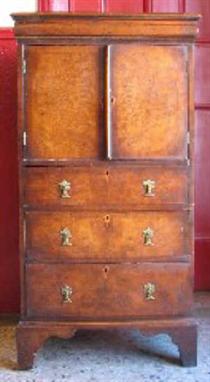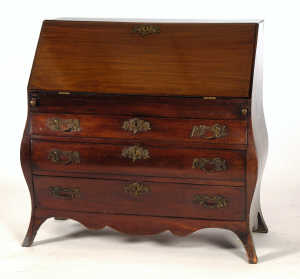177692 Preisdatenbank Los(e) gefunden, die Ihrer Suche entsprechen
177692 Lose gefunden, die zu Ihrer Suche passen. Abonnieren Sie die Preisdatenbank, um sofortigen Zugriff auf alle Dienstleistungen der Preisdatenbank zu haben.
Preisdatenbank abonnieren- Liste
- Galerie
-
177692 Los(e)/Seite
A French tortoiseshell and gilt metal mounted bracket clock, the waisted case with cut brass inlay, foliate mounts and putti finial, glazed side panels, on scroll feet, the cast dial applied with white enamel Roman numerals and signed 'Gouchon, a Paris', the twin barrel movement with outside countwheel striking to a bell, and the wall bracket en suite, 79cm. total height.
AN EBONISED BRACKET CLOCK dial: 7inch silvered chapter ring, central alarm ring, the brass face engraved Tho. Tompion, movement: anchor escapement and two pulls, the back plate also engraved Tho. Tompion, London Fecit, case: engraved with carved stiff foliage,gilt metal folaite basket top, 19in. (48cm.) high
A George IV mahogany bracket clock in the Egyptian style, the enamelled circular dial signed D & W MORICE Fenchurch Street LONDON, with roman chapters and pierced brass hands, the twin fusee movement striking on two bells and signed again on the shaped backplate, the case with a turned finial and fluted pediment between acroteria and with ebonised mouldings, on reeded feet, 55cm h The partnership of David and William Morice lasted from 1818 to 1838. Small filled chip adjacent to one of the winding holes but in overall excellent condition and of finely figured veneers. Minor loss and repaired loss to the acreteria and the side frets. The movement complete and original. In apparently good going order
A George III oak longcase clock, the 12 inch painted dial with subsidiary seconds dial, date sector and brass ringed winding holes signed I&E Mason Worcester having floral spandrels and eight day striking movement in crossbanded case with swan neck pediment, turned pillars and incised pilasters, on bracket feet, 205cm h In fine condition, the movement and dial original to the case, the dial in good order and without repainting etc, the case of fine colour and patina. Attractive cottage longcase.
A George III mahogany chest-on-chest, with dentil cornice above two short and three long figured drawers, the lower part with a brushing slide above three further drawers, on bracket feet, 191cm h; 114 x 54cm Of slightly neglected very dry appearance with some splits and bruises to the side, small loss to the beading around the cornice on one side, the veneers chipped slightly around some of the drawers, the handles complete and probably original
A South German small cabinet inlaid with etched steel plaques, last quarter of the 16th Century of rectangular form, veneered in rosewood, the corners each reinforced by a shaped etched steel bracket, the outer faces each inlaid with pairs of white metal bands framing a raised moulding enclosing a large steel plaque, each etched with scrolling foliage enclosing a central panel of differing scenes, including on the reverse Christ entering Jerusalem on the reverse, a marine monster on one side, a grotesque demi-figure on the other, and with biblical scenes on the top and front, the latter opening to reveal a series of drawers and a central door, the door secured by a contemporary lock, the drawer and panel fronts all inlaid with steel plaques etched with scrolling foliage and strapwork bands, the inside of the lid inlaid with white metal bands and a large steel plaque etched with the Arrest of Christ in the Garden (the carrying handle and keys each missing, the etching with areas of light wear, the veneer with one small chip and cracks on the reverse, one foot associated) 24.1 cm ; 9.5in by 30.4 cm ; 12 in by 21.6 cm ; 8.5in
A Continental bronze proving mortar, mid-18th Century, probably French of substantial weight, cast in one piece with a supporting bracket and moulded rectangular bed, the latter stamped 'No. 12', the barrel cast at 45 degrees and with a series of astragals and raised bands, transverse lifting-handle formed as a pair of conjoined pair of spiralling serpents, bulbous terminal with constricted powder chamber, and the vent with a projecting scalloped lip 16cm., 6.25in bore., 36cm., 14.125in bed length In 1686 the French army adopted a mortar-eprouvette for testing the quality of artillery powder; a number of versions remained in use throughout Europe and in Britain and the United States up to the mid-19th Century.
a rare German etched combined halberd and wheel-lock pistol of the guard of Wolf Dietrich von Raitenau, Prince archbishop of Salzburg, dated 1589 with broad leaf-shaped blade formed with a full-length central gutter on both sides and extending to a long tang, the latter retained within a sheath at the upper end of the socket, small flat rear fluke and atrophied axe-blade each incorporating a pair of rear-swept lugs, a single two-stage pistol barrel seated within the gutter on one side and retained by a moulded bracket at the base of the blade, a single lock mechanism fitted on the right, including flat plate with bevelled tail, external wheel retained by a chiselled ring formed as addorsed dolphins, sliding pan-cover with button release, chiselled dog formed as a monster's head, and the sear working on a long bar linked internally to a folding trigger at the mid-point of the haft, with tubular socket with prominent collar, original wooden haft carved with a nodular pattern over its length, the upper half octagonal and inset with four long iron straps, and two each carrying a folding trigger locked by a sliding catch, the halberd head decorated over its entire surface with interlaced strapwork patterns filled with flowerheads and foliage on a contrasting blackened ground, involving small espagnolettes together with small demonic and cherubic masks, the date 1589 on both sides towards the point of the blade, and the arms of Wolf Dietrich von Raitenau quartered with those of the Archbishopric of Salzburg in a cartouche on both sides of the axe blade, the socket, pistol barrel and lock mechanism all decorated in continuation of the strapwork patterns, and the haft straps lightly etched over their full length with a series of foliate panels previously gilt ( one pistol barrel and one lock mechanism each missing) the head 52.9cm., 20.875in
WM. EWBANK, ELLAND, AN EARLY 19TH CENTURY OAK AND MAHOGANY CROSSBANDED LONGCASE CLOCK, with fan inlay corners, the break arch 'Wilson' rolling moon phase dial with subsidiary seconds and strawberry spandrel corners, the swan neck pediment hood above a shaped top trunk door flank by quarter columns, raised on a stepped base with bracket feet, twin train movement, 93 1/2 ins high.
-
177692 Los(e)/Seite


































